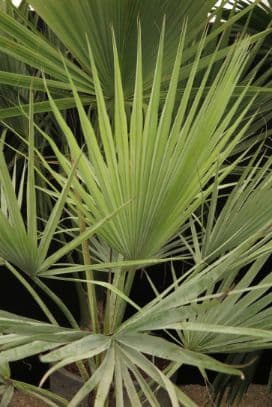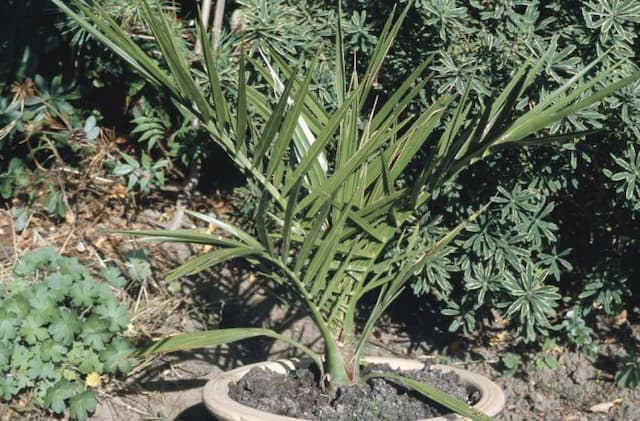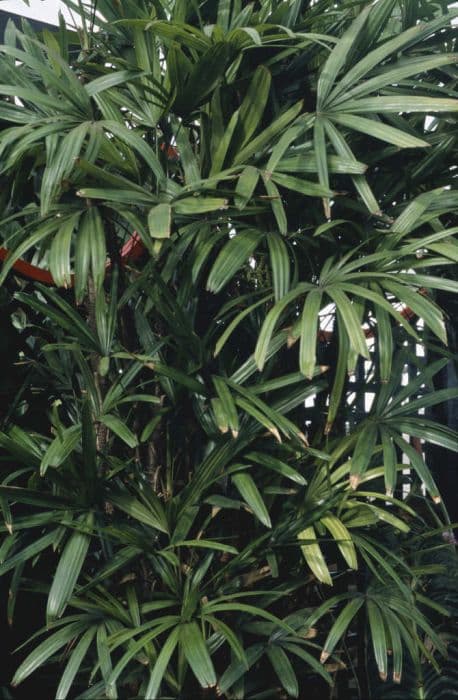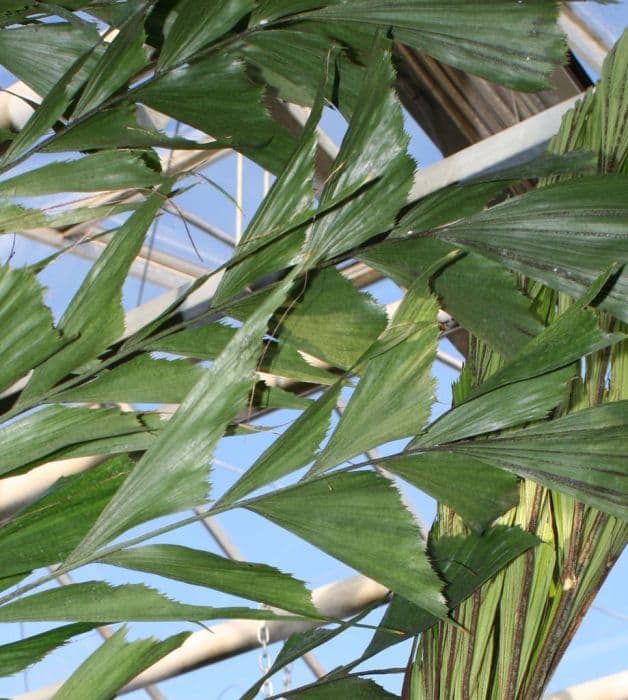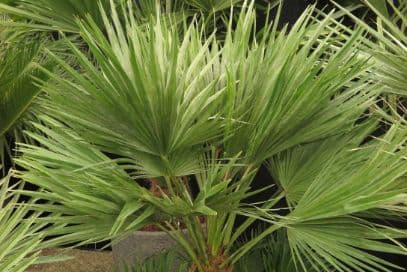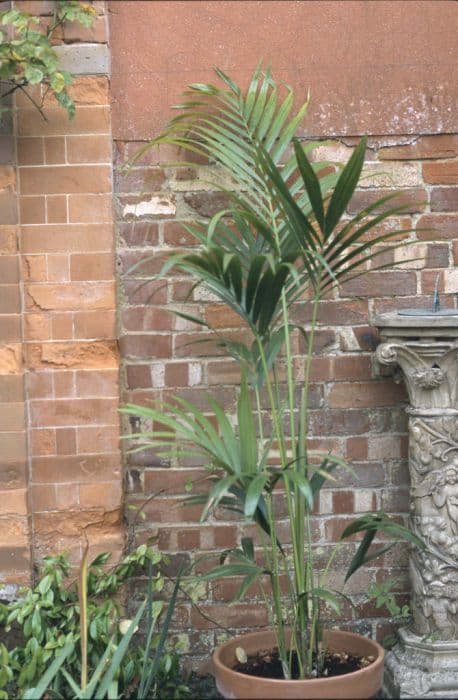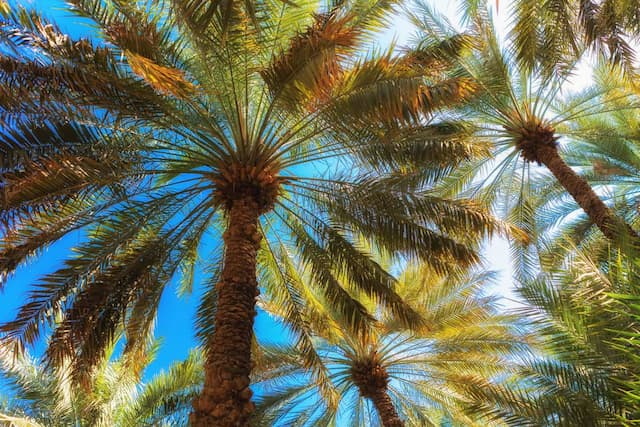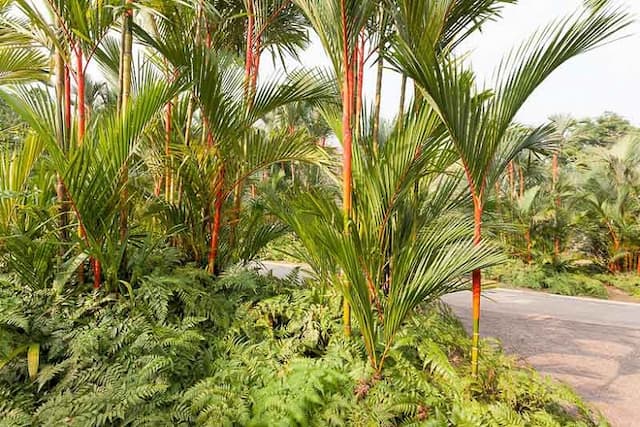Mexican Blue Palm Brahea dulcis

ABOUT
The Mexican Blue Palm, commonly known as the Brahea dulcis, is a visually striking plant that exudes a rugged beauty. It sports a dense crown of fan-shaped leaves with a bluish-green hue, giving it a distinctive and appealing color palette. The leaves themselves are quite sturdy and possess a certain rigidity, adorned at their edges with small teeth, which can be sharp to the touch. Each leaf is supported on a long, slender stalk, which emanates from a stout, central trunk. The trunk is covered in a rough, textured bark that enhances the plant's overall aesthetic with its natural, fibrous appearance. As the leaves mature, they gracefully arch downwards, creating a cascading effect that adds to the palm's charm and character. The Mexican Blue Palm blooms with inconspicuous flowers that cluster together in inflorescences. These appear near the base of the leaves, adding a subtle touch of vitality during their specific blooming season. Following the flowering phase, the plant may produce small, round fruits that further embellish its appearance with a touch of contrasting color and texture amidst the blue-green foliage. Overall, the appearances of resilience and serenity converge in the Mexican Blue Palm, making it a popular choice for ornamental purposes in gardens and landscapes where its distinct color and form can be fully appreciated.
About this plant
 Names
NamesSynonyms
Mexican Blue Palm, Rock Palm, Sweet Brahea, Desert Brahea, Amole Palm, Blue Hesper Palm, Guadalupe Palm, Dwarf Rock Palm, Sombrero Palm, Palma De Sombrero.
Common names
Brahea berlandieri, Erythea dulcis, Glaucothea berlandieri, Neowashingtonia dulcis
 Toxicity
ToxicityTo humans
The plant commonly known as the Mexican Blue Palm (Brahea dulcis) is not widely recognized for its toxicity to humans. This palm species, used ornamentally and for its edible fruits, doesn't typically pose a risk of poisoning when parts are ingested. There is no significant evidence or well-documented cases of toxicity in humans from consuming or handling the Mexican Blue Palm.
To pets
The Mexican Blue Palm (Brahea dulcis) is not known to be toxic to pets. This palm does not contain any known toxins that would pose a threat to animals if ingested. However, as with any non-food plant, ingestion of large amounts could potentially cause gastrointestinal irritation or blockage due to the physical nature of the plant material. It is always prudent to monitor your pets and prevent them from eating large quantities of non-food plants.
 Characteristics
CharacteristicsLife cycle
Perennials
Foliage type
Evergreen
Color of leaves
Green
Height
10 feet (3 meters)
Spread
6 feet (1.8 meters)
Plant type
Palm
Hardiness zones
8
Native area
Mexico
Benefits
 General Benefits
General Benefits- Landscape aesthetics - Brahea dulcis, also known as the Mexican Blue Palm, adds visual interest to gardens with its distinctive silvery-blue foliage and robust trunk.
- Shade provision - With its expansive canopy, the Mexican Blue Palm can provide shade in hot climates, creating cooler areas for relaxation and protection from the sun.
- Erosion control - The root system of this palm helps stabilize soil and prevent erosion on slopes and in areas prone to land degradation.
- Wildlife habitat - It offers a habitat and food source for wildlife, such as birds and insects, which can nest among its leaves or feed on its fruit.
- Drought resistance - Mexican Blue Palm is well-adapted to arid conditions, making it an ideal plant for xeriscaping and water-conserving landscapes.
- Ornamental fruit - The palm produces ornamental fruit that can add to the visual appeal of the landscape.
- Cultural significance - In some regions, the Mexican Blue Palm has cultural importance and may be used in local traditions or ceremonies.
 Medical Properties
Medical Properties- Analgesic: Used traditionally to alleviate pain.
- Anti-inflammatory: May reduce inflammation when applied externally.
- Antirheumatic: Employed in the treatment of rheumatism.
- Gastroprotective: Potential use in protecting the gastric mucosa.
 Air-purifying Qualities
Air-purifying QualitiesThis plant is not specifically known for air purifying qualities.
 Other Uses
Other Uses- The fibers of the Rock Palm can be harvested to make durable ropes and coarse textiles, due to their strength and flexibility.
- In some regions, the seeds of the Rock Palm are used as a substitute for ivory, as they can be carved and polished for small decorative objects.
- The trunks of the Rock Palm may be utilized in construction as a natural building material, specifically for creating rustic furniture or as part of structural supports in rural areas.
- Leaves of the Rock Palm, when dried, have traditionally served as thatching material for roofs in local indigenous housing.
- The sap of the Rock Palm can be fermented to produce an alcoholic beverage, similar to the way sap from other palm species is used to make palm wine.
- Rock Palm hearts, the inner core of the palm, can be consumed as a food source, although it's not a common practice due to sustainability concerns.
- In some cultures, the large leaves of the Rock Palm are used during religious or festive ceremonies as decorations or as part of ritual attire.
- The hard shells of the Rock Palm seeds can be used to make jewelry or as elements in mosaic art, due to their durability and unique texture.
- Rock Palm can be planted as an ornamental plant in xeriscaped gardens, as its drought tolerance makes it suitable for arid and semiarid environments.
- The Rock Palm may be used in reforestation projects or soil stabilization efforts in areas prone to erosion due to its adaptive root system and overall hardiness.
Interesting Facts
 Feng Shui
Feng ShuiThe Mexican Blue Palm is not used in Feng Shui practice.
 Zodiac Sign Compitability
Zodiac Sign CompitabilityThe Mexican Blue Palm is not used in astrology practice.
 Plant Symbolism
Plant Symbolism- Resilience: The Brahea dulcis, commonly known as the Rock Palm, is native to rocky and arid environments, symbolizing the ability to withstand harsh and challenging conditions.
- Longevity: Rock Palms can live for many years, representing endurance and the passage of time.
- Adaptability: As a plant thriving in difficult terrains, it stands for versatility and the capacity to adapt to changing circumstances.
 Water
WaterThe Mexican Blue Palm should be watered deeply but infrequently, as it is adapted to arid conditions. During the growing season, water the plant every two to three weeks with approximately 2 gallons of water, ensuring that the soil is allowed to dry out between waterings. In the winter months, reduce watering to once a month or less, depending on the climate. Always check the top few inches of soil for dryness before watering. Overwatering can lead to root rot, so it's important to avoid letting the plant sit in waterlogged soil.
 Light
LightThe Mexican Blue Palm thrives in full sun to partial shade. The ideal location for this plant is a spot where it can receive at least 6 hours of direct sunlight daily. If planted indoors, it should be placed near a south-facing window to ensure it gets ample light. The plant is well suited to outdoor growth in sunny areas of the garden where it can receive unfiltered sunlight throughout the day.
 Temperature
TemperatureThe Mexican Blue Palm prefers warm temperatures, thriving in a range between 50°F and 90°F. It can tolerate brief periods of colder weather down to about 20°F but should be protected from prolonged exposure to freezing temperatures. Optimum growth occurs when the daytime temperature is around 70°F to 80°F.
 Pruning
PruningThe Mexican Blue Palm should be pruned to remove dead or dying fronds, which helps prevent pests and diseases. Pruning is also done to maintain a tidy appearance. Prune sparingly, as the plant does not require frequent trimming. The best time to prune is in the spring or early summer, to allow for healing and regrowth in the growing season.
 Cleaning
CleaningAs needed
 Soil
SoilThe Mexican Blue Palm (Brahea dulcis) thrives in well-draining soil with a sandy or loamy texture; a cactus mix combined with pumice or perlite can work well. The pH should be mildly acidic to neutral, ideally between 6.0 and 7.5.
 Repotting
RepottingMexican Blue Palms (Brahea dulcis) are slow growers and require repotting only every 3 to 4 years or when they outgrow their current pot.
 Humidity & Misting
Humidity & MistingMexican Blue Palm (Brahea dulcis) tolerates a wide range of humidity levels but prefers moderate to low humidity akin to its native desert habitat conditions.
 Suitable locations
Suitable locationsIndoor
Provide bright light and good air circulation for indoor Mexican Blue Palms.
Outdoor
Plant in full sun, well-draining soil, protect young plants from frost.
Hardiness zone
9-11 USDA
 Life cycle
Life cycleBrahea dulcis, commonly known as Mexican Blue Palm, starts its life cycle with seed germination, which occurs when conditions are warm and moist. After germination, a seedling emerges, developing a root system and a single shoot that will grow into a juvenile palm. Over several years, the palm continues its growth, developing a sturdy trunk and a crown of blue-green, fan-shaped leaves. As it matures, it begins to flower, producing inflorescences that bear small, white flowers, which are then pollinated by wind or insects. Following successful pollination, fruits develop which contain seeds, completing the reproductive cycle. The Mexican Blue Palm can live for many decades, possibly over a century, slowly growing in height and girth throughout its lifetime.
 Propogation
PropogationPropogation time
Spring-early summer
The most popular method of propagating the Mexican Blue Palm (Brahea dulcis) is through seeds. Seed collection should be done when the fruit is ripe, indicated by a change in color from green to blue or black. Once collected, the seeds can be cleaned and sown immediately or stored for short periods. High germination rates are often achieved with fresh seeds. It's crucial to plant the seeds in well-draining soil, maintaining a temperature of around 85°F (29.4°C) to encourage germination. Germination can be slow, sometimes taking several months. Regular watering is necessary, but care must be taken to avoid waterlogged conditions which could lead to rot.
